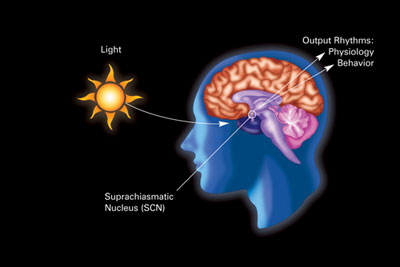A circadian rhythm is any biological process which displays an endogenous, entrainable oscillation of about 24 hours.
(Entrainment means that within the study of chronobiology, occurs when rhythmic physiological or behavioral events match their period and phase to that of an environmental oscillation)
These rhythms are driven by (or composed of) a circadian clock, and rhythms have been widely observed in plants, animals, fungi and cyanobacteria.
The term circadian comes from the Latin circa, meaning "around" (or "approximately"), and diem or dies, meaning "day".
The formal study of biological temporal rhythms, such as daily, tidal, weekly, seasonal, and annual rhythms, is called chronobiology.
Although circadian rhythms are endogenous ("built-in", self-sustained), they are adjusted (entrained) to the local environment by external cues called zeitgebers, commonly the most important of which is daylight.
(Entrainment means that within the study of chronobiology, occurs when rhythmic physiological or behavioral events match their period and phase to that of an environmental oscillation)
These rhythms are driven by (or composed of) a circadian clock, and rhythms have been widely observed in plants, animals, fungi and cyanobacteria.
The term circadian comes from the Latin circa, meaning "around" (or "approximately"), and diem or dies, meaning "day".
The formal study of biological temporal rhythms, such as daily, tidal, weekly, seasonal, and annual rhythms, is called chronobiology.
Although circadian rhythms are endogenous ("built-in", self-sustained), they are adjusted (entrained) to the local environment by external cues called zeitgebers, commonly the most important of which is daylight.
Some features of the human circadian biological clock
ONCE THIS is understood - you will understand JET LAG better - Tomorrow!


